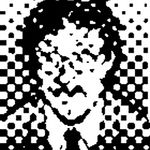Copy link to clipboard
Copied
Can someone PLEASE, for the love of all that is holy, tell me how to create this shape?! It's just a simple pointed arch. Nothing fancy. Just the shape. Not even the circles within. I have scoured the internet and come up with NOTHING. Insanely frustrating. THANK YOU!
 1 Correct answer
1 Correct answer
Boomstick,
Disregarding an inferior Image Trace, in any case you can start by placing (a copy of) the image on a Template Layer and then redraw on a (live) Layer above it.
For a close resemblance including the asymmetry, the obvious way will be to (re)draw with the Pen Tool.
For a more stylized symmetric appearance you can start with an adapted (Rectangle Tool) rectangle at the bottom and an adapted (Ellipse Tool) ellipse (to fit the lower part of the arch) at the top (same width), then Pa
...Explore related tutorials & articles
Copy link to clipboard
Copied
Boomstick,
Disregarding an inferior Image Trace, in any case you can start by placing (a copy of) the image on a Template Layer and then redraw on a (live) Layer above it.
For a close resemblance including the asymmetry, the obvious way will be to (re)draw with the Pen Tool.
For a more stylized symmetric appearance you can start with an adapted (Rectangle Tool) rectangle at the bottom and an adapted (Ellipse Tool) ellipse (to fit the lower part of the arch) at the top (same width), then Pathfinder>Unite (or use Shape Builder), and then use the Convert Anchor Tool (bundled with the Pen Tool) on the top Anchor Point and ShiftClickDDrag it up to (the best fit of) the pointed top.
Or you can draw the left/right part (depending on which you prefer) with the Pen Tool from the top to the bottom corner, then (Object>Transform>) Reflect it vertically and join, then join again to create the bottom segment and close the path.
Copy link to clipboard
Copied
Thank you so much for the response and taking time to run through the steps. This works really well!
Copy link to clipboard
Copied
You are welcome, Boomstick.
May I ask which way you went (with)?

Copy link to clipboard
Copied
Thank you so much. That's been driving me mad for hours.
Copy link to clipboard
Copied
You are welcome, lexi ley.
Copy link to clipboard
Copied
Should not be very difficult when you have learned the basics.
See here how to create shapes and use the pen tool:
Copy link to clipboard
Copied
Hi Boomstick. I realize that your question is a couple years old but I was looking for the same thing. I want to know the porportion and geometry of medieval arches, and I want to be able to create them using Adobe illustrator as pen outlines. I don't want to trace them or freehand them. There is material on the web that explains drafting geometry of Medieval arches. I haven't found anything yet that explains the height and width porportion requirements. I've found authoritative declarations of 'how to draft the lancet arch' and 'tudor arch' and 'four point arch' and stuff like that. But I'd also like to have a comprehensive set of rules for each arch that factors variable height and width, or that explains why you cannot use just any old relationship between height and width and still be authentic. I haven't found anything in English yet. But I was wondering whether over the years since you posted your question, did you find any good information? Thank's much.
Copy link to clipboard
Copied
frogacuda,
Basically, the Gothic arch has two arcs = parts of circles meeting at the top with a sharp corner.
There are three types:
The taller/narrower/sharper lancet arch where the arc radius is larger than the arch width so the centre of each arc is outside the opposite side of the arch;
The equlateral arch where the arc radius is identical to the arch width so the centre of each arc is at the opposite side of the arch, and an equilateral triangle fits within it;
The lower/wider/rounder drop arch where the arc radius is smaller than the arch width so the centre of each arc is inside the opposite side of the arch.
You can have a look at Figure 2 here which shows a drop arch where the arc radius is 4/5 of the arch width (Quinto acuto),
https://archive.schillerinstitute.com/educ/pedagogy/2013/vereycken-dome-1.html
So it is a simple matter of choosing and creating the arcs with the Ellipse Tool (W = H being twice the arc radius).
Concerning authenticity/beauty, you can look at (images of) arches from the old days and stay within the limits of those recognized (or even praised)/beautiful.
Obviously, quinto acuto is a safe bet, as is equilateral, in the middle of the possible range, maybe quinto acuto being considered the classical/superior shape.
The upper recognized limit for lancet arches may be an arc with a radius twice the arch width (the term is double span).
Obviously, the lower limit is something with a distinct sharpness, clearly different to the fully rounded Roman arch corresponding to an arc radius half the arch width.
Copy link to clipboard
Copied
Don't know if this will help, but https://www.dimensions.com/element/arch-gothic.
Find more inspiration, events, and resources on the new Adobe Community
Explore Now



